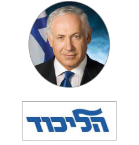Introduction: Major Issues for U.S.-Israel Relations
Israel has forged close bilateral cooperation with the United States in many areas; issues with significant implications include the following.
- Israeli domestic political issues, especially questions surrounding Prime Minister Binyamin Netanyahu's prospects of continuing as prime minister following Israel's March 2 election, the third in the past year.
- Israeli-Palestinian issues and U.S. policy, including the Trump Administration's peace plan released in January 2020 and issues surrounding possible Israeli West Bank annexation.
- Israel's own capabilities for addressing external threats, and its cooperation with the United States.
- Shared U.S.-Israel concerns about Iran's nuclear program and regional influence, including with Iran's Lebanon-based ally Hezbollah. In the past year, Israel has reportedly engaged in airstrikes against Iranian or Iran-allied targets in Syria and Iraq as well as Lebanon.
For background information and analysis on these and other topics, including aid, arms sales, and missile defense cooperation, see CRS Report RL33476, Israel: Background and U.S. Relations, by Jim Zanotti; and CRS Report RL33222, U.S. Foreign Aid to Israel, by Jeremy M. Sharp.
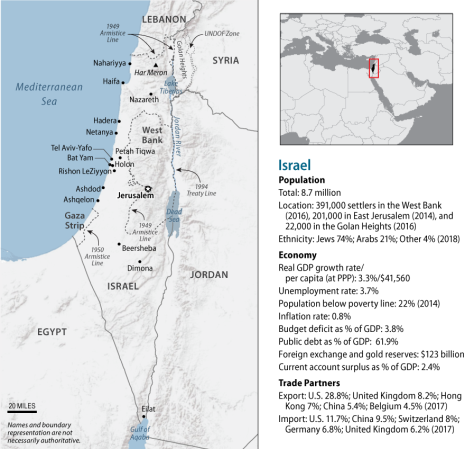 |
|
Sources: Graphic created by CRS. Map boundaries and information generated by Hannah Fischer using Department of State Boundaries (2011); Esri (2013); the National Geospatial-Intelligence Agency GeoNames Database (2015); DeLorme (2014). Fact information from CIA, The World Factbook; Economist Intelligence Unit; IMF World Economic Outlook Database. All numbers are estimates as of 2019 unless specified. Notes: According to the U.S. executive branch: (1) The West Bank is Israeli occupied with current status subject to the 1995 Israeli-Palestinian Interim Agreement; permanent status to be determined through further negotiation. (2) The status of the Gaza Strip is a final status issue to be resolved through negotiations. (3) The United States recognized Jerusalem as Israel's capital in 2017 without taking a position on the specific boundaries of Israeli sovereignty. (4) Boundary representation is not necessarily authoritative. Additionally, the United States recognized the Golan Heights as part of Israel in 2019; however, U.N. Security Council Resolution 497, adopted on December 17, 1981, held that the area of the Golan Heights controlled by Israel's military is occupied territory belonging to Syria. The current U.S. executive branch map of Israel is available at https://www.cia.gov/library/publications/the-world-factbook/attachments/maps/IS-map.gif. |
Domestic Issues: Will Netanyahu Remain Prime Minister?
On March 2, 2020, Israel held its third election in the past year because neither of the previous two elections (in April and September 2019) resulted in the formation of a new government. Before this political stalemate, no Israeli election had failed to garner Knesset majority support for a new government. According to unofficial results, the Likud party, led by Prime Minister Netanyahu, won the most Knesset seats in the March 2 election (see Appendix A), despite criminal indictments against Netanyahu for corruption (see Appendix B). However, the bloc of right-of-center and ultra-Orthodox parties that are Netanyahu's traditional political allies are three seats short of a majority, partly due to a strong showing by the Arab-led Joint List, which was reportedly fueled by high turnout from Israel's Arab citizens and some Jewish votes.1 Netanyahu's criminal trial is scheduled to begin on March 17, though he has requested a 45-day postponement.2
The person who will be assigned in mid-March by Israeli President Reuven Rivlin to form a government will have an initial four weeks to build a coalition, followed by a possible two-week extension, and possibly opportunities for someone else if the first person is unsuccessful.3 If no one can garner majority support for a new government, another election would presumably take place later in 2020. Netanyahu—or, if he leaves office, a successor—will serve as prime minister in a caretaker or interim capacity until someone establishes a majority-backed coalition.4
Despite Likud's three-seat electoral advantage over Benny Gantz and his Kahol Lavan party (see Appendix A), Gantz may have enough support from the other parties that oppose Netanyahu (Joint List, Labor-Gesher-Meretz, and Yisrael Beitenu) to receive President Rivlin's first mandate to form a government.5 If that happens, a Knesset majority could pass a bill that would prevent Netanyahu—due to the indictments he faces—from forming a government. It is unclear whether the bill, if enacted, would affect this government formation process or only apply if another election takes place.6 Reports have surfaced that Avigdor Lieberman of Yisrael Beitenu—a right-of-center, pro-secular party—may support the proposed bill and recommend that Gantz form the next government.7 However, Lieberman has been unwilling to date to join either a Gantz-led government supported by the Arab-led Joint List, or a Netanyahu-led government with ultra-Orthodox parties.8 Unless that changes, Israel's yearlong political stalemate may continue, with a number of possibilities if the parties go to a fourth election.9
Possible outcomes leading to a majority-backed coalition from the March election include:
- Unity government if Gantz and Netanyahu agree to govern together.
- Minority government if Gantz is willing and able to govern with other parties opposed to Netanyahu, and with the outside support of the Joint List.10
- Right-of-center majority if Netanyahu can get at least three Knesset members from other parties to join with his traditional coalition allies.11
If Netanyahu forms the next government, he may pursue initiatives that could reduce the independence of Israel's judiciary and lead to West Bank annexation.12 It is unclear how a unity government or a government without Netanyahu might approach these issues, and whether Netanyahu could annex West Bank territory under Israeli law while acting in a caretaker capacity.13 Netanyahu has promised to annex significant territory in the West Bank in conjunction with the Israeli-Palestinian peace plan released by President Trump on January 28, 2020.14
Israeli-Palestinian Issues Under the Trump Administration15
President Trump has expressed interest in helping resolve the decades-old Israeli-Palestinian conflict. However, his policies have largely favored Israeli positions, thus alienating Palestine Liberation Organization (PLO) Chairman and Palestinian Authority (PA) President Mahmoud Abbas.
Selected U.S. Actions Impacting Israeli-Palestinian Issues
|
December 2017 |
President Trump recognizes Jerusalem as Israel's capital, prompting the PLO/PA to cut off high-level diplomatic relations with the United States |
|
May 2018 |
U.S. embassy opens in Jerusalem |
|
August 2018 |
Administration ends contributions to U.N. Relief and Works Agency for Palestine Refugees in the Near East (UNRWA) |
|
September 2018 |
Administration reprograms FY2017 economic aid for the West Bank and Gaza to other locations; announces closure of PLO office in Washington, DC |
|
January 2019 |
As a result of the Anti-Terrorism Clarification Act of 2018 (P.L. 115-253), the Administration ends all bilateral U.S. aid to the Palestinians |
|
March 2019 |
The U.S. consulate general in Jerusalem—previously an independent diplomatic mission to the Palestinians—is subsumed under the authority of the U.S. embassy to Israel; President Trump recognizes Israeli sovereignty in the Golan Heights |
|
June 2019 |
At a meeting in Bahrain, U.S. officials roll out $50 billion economic framework for Palestinians in the region tied to the forthcoming peace plan; PLO/PA officials reject the idea of economic incentives influencing their positions on core political demands |
|
November 2019 |
Secretary of State Michael Pompeo says that the Administration disagrees with a 1978 State Department legal opinion stating that Israeli West Bank settlements are inconsistent with international law |
|
January 2020 |
President Trump releases peace plan |
On January 28, President Trump released a long-promised "Peace to Prosperity" plan for Israel and the Palestinians,16 after obtaining expressions of support from both Netanyahu and Gantz. Prospects for holding negotiations seem dim given concerted opposition from Abbas and other Palestinian leaders, and Netanyahu's announced intention to annex parts of the West Bank. Members of Congress have had mixed reactions to the plan.17
Key Points of the U.S. Plan
The plan suggests the following key outcomes as the basis for future Israeli-Palestinian negotiations:18
|
Settlement-Related Announcements After the Plan's Release In February, Netanyahu and his government announced intentions to move forward with plans or construction for Jewish settlements in areas of East Jerusalem (where some refer to settlements as neighborhoods) and the West Bank—including an area known as E-1—that could significantly obstruct territorial contiguity between Palestinian population centers.19 |
- Borders and settlements. Israel would acquire sovereignty over about 30% of the West Bank (see Figure C-1), including settlements and most of the Jordan Valley.20 The Palestinians could eventually acquire a limited form of sovereignty (as described below) over the remaining territory. This includes areas that the Palestinian Authority (PA) currently administers, along with some territory currently belonging to Israel (with few Jewish residents) that the Palestinians would acquire via swaps to partially compensate for West Bank territory taken by Israel. Some areas with minimal contiguity would be connected by roads, bridges, and tunnels (see Figure C-2). Neither Israeli settlers nor Palestinian West Bank residents would be forced to move. The plan anticipates that an agreement could transfer some largely Israeli Arab communities—including an area called the "Arab Triangle"—to a future Palestinian state. In the days after the plan's release, hundreds of residents of the Triangle communities protested the possibility that their citizenship could change, prompting senior Israeli officials to state that the Triangle communities would not be involved in any border revision.21
- Jerusalem and its holy sites. Israel would have sovereignty over nearly all of Jerusalem, with the Palestinians able to obtain some small East Jerusalem areas on the other side of an Israeli separation barrier.22 Taken together, the plan and its accompanying White House fact sheet say that the "status quo" on the Temple Mount/Haram al Sharif—which prohibits non-Muslim worship there—would continue, along with Jordan's custodial role regarding Muslim holy sites.23 However, the plan also says, "People of every faith should be permitted to pray on the Temple Mount/Haram al-Sharif, in a manner that is fully respectful to their religion, taking into account the times of each religion's prayers and holidays, as well as other religious factors." A day after the plan's release, U.S. Ambassador to Israel David Friedman clarified that the status quo would not change absent the agreement of all parties, while adding that the Administration hoped that an eventual accord would allow Jews to pray on the Temple Mount as part of greater openness "to religious observance everywhere."24
- Security. Israel would retain overall security control over the entire West Bank permanently, though Palestinians would potentially assume more security responsibility, over time, in territory they administer.25
- Palestinian refugees. Palestinian refugee claims would be satisfied through internationally funded compensation and resettlement outside of Israel (i.e., no "right of return" to Israel) in the West Bank, Gaza, and third-party states.
- Palestinian statehood. The Palestinians could obtain a demilitarized state within the areas specified in Figure C-2 and Figure C-3, with a capital in Abu Dis or elsewhere straddling the East Jerusalem areas mentioned above and their outskirts.26 Statehood would depend on the Palestinians meeting specified criteria over the next four years that present considerable domestic and practical challenges.27 Such criteria include disarming Hamas in Gaza, ending certain international initiatives and financial incentives for violence, and recognizing Israel as "the nation state of the Jewish people."28
Possible Israeli West Bank Annexation
Shortly after the release of the U.S. plan, Prime Minister Netanyahu announced an intention to have the Israeli government annex West Bank settlements and the Jordan Valley.29 His initial proposal to act immediately—supported by some comments from U.S. ambassador to Israel David Friedman30—changed in light of January 30 remarks by White House Senior Adviser Jared Kushner. Kushner said that technical discussions involving a U.S.-Israel committee to pinpoint areas earmarked for eventual Israeli sovereignty (see Figure C-1) could begin immediately, but that finalizing them would take "a couple of months." Kushner also said that an Israeli government would need to be in place "in order to move forward" with annexation.31
In the wake of Kushner's statements, Netanyahu claimed that he would only seek government approval for annexation after the March 2 election.32 Some observers have speculated that Kushner wants to give the plan an opportunity to garner international support before annexation takes place.33 The U.S.-Israel mapping committee began meeting in February.34 On March 5, one source reported that Kushner told Members of Congress that the United States would be ready to support Israeli annexation within a matter of months if the Palestinians are unwilling to negotiate with Israel on the basis of the U.S. plan.35
Annexation could affect the prospects of reaching a negotiated two-state solution, based on either the U.S. plan or other starting points. Two former U.S. officials have written that "if Israeli annexation is front-loaded and proceeds in the coming months, any Palestinian counter-offer would be pre-empted."36
|
Annexation Under Israeli Law Since Israel's founding in 1948, it has effectively annexed two territories: East Jerusalem and the Golan Heights, both of which Israel captured in the 1967 Arab-Israeli war. Shortly after the war, the Israeli government expanded Jerusalem's municipal boundaries to include all of the previously Jordanian-held East Jerusalem and some surrounding West Bank territory, and proclaimed the municipality to be Israel's capital. The Knesset passed a Basic Law in July 1980 stating that the jurisdiction of Jerusalem runs throughout the expanded municipal boundaries. In December 1981, the Knesset passed a law stating that the "Law, jurisdiction and administration of the state [of Israel] shall apply to the Golan Heights."37 The U.N. Security Council, in Resolutions 478 (1980) and 497 (1981), respectively, affirmed that both Knesset laws were violations of international law. According to one Israeli legal scholar, under domestic law Israel can apply its law to new territory via governmental decree (if the territory was previously part of the British Mandate of Palestine) or Knesset legislation.38 Some norms of Israeli law already apply to West Bank settlements, "either through application of personal jurisdiction over the settlers, or through military decrees that incorporated Israeli law into the law applicable to all or parts of the West Bank."39 According to one article citing various Israeli legal experts, Israel could take a range of approaches to annexation or applying its law to West Bank areas.40 The full application of Israeli law to settlements could necessitate significant adaptation in matters such as property registry and land-use planning. Also, if Israel applies its civilian law to the Jordan Valley or other West Bank areas with Palestinian populations currently subject to Jordanian and military law, the legal transition could potentially impact individual property rights and business licenses.41 Since 2016, various Knesset members have reportedly proposed bills that would apply Israeli law, jurisdiction, administration, and formal sovereignty in specified West Bank areas.42 |
Annexation may be contrary to international law,43 including various U.N. Security Council resolutions and existing Israeli-Palestinian agreements (the Oslo Accords of the 1990s) that provide for resolving the status of the West Bank and Gaza Strip via negotiations.44 U.N. Security Council Resolution 2334, adopted in December 2016 with the United States (under the Obama Administration) abstaining, stated that settlements established by Israel in "Palestinian territory occupied since 1967, including East Jerusalem," constitute "a flagrant violation under international law" and a "major obstacle" to a two-state solution and a "just, lasting and comprehensive peace." In December 2019, the House (by a vote of 226-188, with two voting present) passed H.Res. 326, which called for any future U.S. peace proposal to expressly endorse a two-state solution and discouraged steps such as "unilateral annexation of territory or efforts to achieve Palestinian statehood status" outside negotiations.
Regional and International Reactions to the U.S. Plan
The U.S. plan has elicited various regional and international reactions. While some key actors have voiced hope that the plan's release can lead to the resumption of Israeli-Palestinian talks, others have expressed caution or criticism about the plan.
After a meeting of the foreign ministers of the League of Arab States on February 1, the Arab League issued a communique saying that it would not cooperate with the United States to implement the plan and that Israel should not forcibly carry it out.45 It stated its view that the Arab Peace Initiative of 2002 remains the proper basis for a negotiated Israeli-Palestinian peace.46 In the days before the Arab League meeting, Saudi Arabia, Egypt, and the United Arab Emirates expressed qualified openness to supporting a negotiating process based on the plan.47 Some observers surmise that some key Arab states' shared interests with Israel on Iran and other matters may lead them to be less insistent than in the past on Israel meeting Palestinian demands.48
The impact of the plan or possible Israeli annexation on neighboring Jordan is an important issue.49 Israeli security officials regard Jordan, with which Israel has a peace treaty, as a key regional buffer for Israel. Jordan also hosts key U.S. military assets. While Jordan's monarchy maintains discreet security cooperation with Israel, much of its population—a majority of which is of Palestinian origin—holds negative views about Israel-Jordan relations,50 which have become strained over the past year.51 Additionally, Palestinians might look to Jordan to take greater responsibility for them if their own national aspirations remain unfulfilled.52 After the plan's release, Jordanian Foreign Minister Ayman Safadi warned against the "dangerous consequences of unilateral Israeli measures, such as the annexation of Palestinian lands, the building and expansion of illegal Israeli settlements on occupied Palestinian lands and encroachments on the Holy Sites in Jerusalem, that aim at imposing new realities on the ground."53
Other international reactions have encouraged the idea of resuming Israeli-Palestinian negotiations, but raised concerns about parts of the U.S. plan or possible Israeli annexation. For example, Josep Borrell, the European Union High Representative for Foreign Affairs, said on February 4 that the plan departs from internationally agreed parameters for a two-state solution and that Israeli annexation steps "could not pass unchallenged."54 Additionally, annexation could come under investigation by the International Criminal Court (ICC),55 given that the ICC prosecutor has announced her intention to investigate possible war crimes in the West Bank and Gaza if a pre-trial chamber decides that the ICC has jurisdiction there.56
Gaza and Its Challenges
The Gaza Strip—controlled by the Sunni Islamist group Hamas (a U.S.-designated terrorist organization)—faces difficult and complicated political, economic, and humanitarian conditions.57 Palestinian militants in Gaza regularly clash with Israel's military as it patrols Gaza's frontiers with Israel, and the clashes periodically escalate toward larger conflict. Hamas and Israel are reportedly working through Egypt and Qatar in efforts to establish a long-term cease-fire around Gaza that could ease Israel-Egypt access restrictions for people and goods.
How Israel Addresses Threats
Israel relies on a number of strengths to manage potential threats to its security and existence. These strengths include robust military and homeland security capabilities, as well as close cooperation with the United States.
Military Superiority and Homeland Security Measures
Israel maintains military superiority relative to neighboring states and the Palestinians. Shifts in regional order and evolving asymmetric threats have led Israel to update its efforts to project military strength, deter attack, and defend its population and borders. Israel appears to have reduced some unconventional threats via missile defense systems, reported cyber defense and warfare capabilities, and other heightened security measures.
Israel has a robust homeland security system featuring sophisticated early warning practices and thorough border and airport security controls; most of the country's buildings have reinforced rooms or shelters engineered to withstand explosions. Israel also has partially constructed a national border fence network of steel barricades (accompanied at various points by watchtowers, patrol roads, intelligence centers, and military brigades) designed to minimize militant infiltration, illegal immigration, and smuggling from Egypt, Syria, Lebanon, Jordan, and the Gaza Strip.58 Additionally, Israeli authorities have built a separation barrier in and around parts of the West Bank.59
U.S. Cooperation
Israeli officials closely consult with U.S. counterparts in an effort to influence U.S. decision-making on key regional issues, and U.S. law requires the executive branch to take certain actions to preserve Israel's "qualitative military edge," or QME.60 Additionally, a 10-year bilateral military aid memorandum of understanding (MOU)—signed in 2016—commits the United States to provide Israel $3.3 billion in Foreign Military Financing and to spend $500 million annually on joint missile defense programs from FY2019 to FY2028, subject to congressional appropriations. The United States and Israel do not have a mutual defense treaty or agreement that provides formal U.S. security guarantees,61 though some discussions about the possibility of a treaty have apparently taken place since September 2019.62
Iran and the Region
Israeli officials cite Iran as a primary concern to Israeli officials, largely because of (1) antipathy toward Israel expressed by Iran's revolutionary regime, (2) Iran's broad regional influence (especially in Syria, Iraq, and Lebanon),63 and (3) Iran's nuclear and missile programs and advanced conventional weapons capabilities. Israel and Arab Gulf states have cultivated closer relations with one another in efforts to counter Iran.
Iranian Nuclear Issue and Regional Tensions
Prime Minister Netanyahu has sought to influence U.S. decisions on the international agreement on Iran's nuclear program (known as the Joint Comprehensive Plan of Action, or JCPOA). He opposed the JCPOA when it was negotiated by the Obama Administration, and welcomed President Trump's May 2018 withdrawal of the United States from the JCPOA and accompanying reimposition of U.S. sanctions on Iran's core economic sectors. Facing the intensified U.S. sanctions, Iran has reduced its compliance with the 2015 agreement.
U.S.-Iran tensions since the U.S. withdrawal from the JCPOA have led to greater regional uncertainty, with implications for Israel.64 Some Israelis have voiced worries about how Iran's apparent ability to penetrate Saudi air defenses and target Saudi oil facilities could transfer to efforts in targeting Israel.65
Syria, Iraq, and Lebanon
Hezbollah
Lebanese Hezbollah is Iran's closest and most powerful non-state ally in the region. Hezbollah's forces and Israel's military have sporadically clashed near the Lebanese border for decades—with the antagonism at times contained in the border area, and at times escalating into broader conflict.66 Speculation persists about the potential for wider conflict and its regional implications.67 Israeli officials have sought to draw attention to Hezbollah's buildup of mostly Iran-supplied weapons—including reported upgrades to the range, precision, and power of its projectiles—and its alleged use of Lebanese civilian areas as strongholds.68
Ongoing tension between Israel and Iran raises questions about the potential for Israel-Hezbollah conflict. Various sources have referenced possible Iran-backed Hezbollah initiatives to build precision-weapons factories in Lebanon.69 In late 2018 and early 2019, Israel's military undertook an effort—dubbed "Operation Northern Shield"—to seal six Hezbollah attack tunnels to prevent them from crossing into Israel.70 In August 2019, Israel may have conducted airstrikes targeting Hezbollah personnel and advanced drone and missile technology in Syria and Lebanon.71 Hezbollah appeared to respond to Israel in early September with cross-border fire from Lebanon targeting an Israeli military unit,72 amid reports that Hezbollah sought to retaliate but avoid escalation toward war.73
Syria and Iraq: Reported Israeli Airstrikes Against Iran-Backed Forces
Israel has reportedly undertaken airstrikes in conflict-plagued Syria and Iraq based on concerns that Iran and its allies could pose threats to Israeli security from there. Iran's westward expansion of influence into Iraq and Syria over the past two decades has provided it with more ways to supply and support Hezbollah, apparently leading Israel to increasingly broaden its regional theater of military action.74 The U.S. base at At Tanf in southern Syria reportedly serves as an impediment to Iranian efforts to create a land route for weapons from Iran to Lebanon.75 Russia, its airspace deconfliction mechanism with Israel, and some advanced air defense systems that it has deployed or transferred to Syria also influence the various actors involved.76
Since 2018, Israeli and Iranian forces have repeatedly targeted one another in Syria or around the Syria-Israel border. After Iran helped Syria's government regain control of much of the country, Israeli leaders began pledging to prevent Iran from constructing and operating bases or advanced weapons manufacturing facilities in Syria.77
In Iraq, reports suggest that in the summer of 2019, Israel conducted airstrikes against weapons depots or convoys that were connected with Iran-allied Shiite militias. A December 2019 media report citing U.S. officials claimed that Iran had built up a hidden arsenal of short-range ballistic missiles in Iraq that could pose a threat to U.S. regional partners, including Israel.78 Perhaps owing to sensitivities involving U.S. forces in Iraq, Israeli Defense Minister Naftali Bennett suggested in February 2020 that Israel would avoid further direct involvement there—leaving any efforts to counter Iran-backed forces in Iraq to the United States.79
Appendix A. Israeli Political Parties in the Next Knesset and Their Leaders
|
RIGHT |
|
|
|
Likud (Consolidation) – 36 Knesset seats Leader: Binyamin Netanyahu |
|
|
Yisrael Beitenu (Israel Our Home) – 7 seats Leader: Avigdor Lieberman |
|
|
Yamina (Right) – 6 seats Leader: Naftali Bennett |
|
LEFT |
|
|
|
Labor-Gesher-Meretz – 7 seats Leader: Amir Peretz |
|
CENTER |
|
|
|
Kahol Lavan (Blue and White) – 33 seats Merger between two centrist parties, Hosen L'Yisrael (Resilience) and Yesh Atid (There Is a Future). Leader: Benny Gantz |
|
|
|
|
|
Shas (Sephardic Torah Guardians) – 9 seats Leader: Aryeh Deri |
|
|
United Torah Judaism – 7 seats Leader: Yaakov Litzman |
|
|
|
|
|
Joint List – 15 seats Electoral slate featuring four Arab parties that combine socialist, Islamist, and Arab nationalist political strains: Hadash (Democratic Front for Peace and Equality), Ta'al (Arab Movement for Renewal), Ra'am (United Arab List), Balad (National Democratic Assembly). Leader: Ayman Odeh |
Sources: Various open sources.
Note: Knesset seat numbers based on unofficial results from the March 2, 2020, election.
Appendix B. Indictments Against Netanyahu and Steps of the Legal Process
|
Indictments |
|
Case 1000: Netanyahu received favors from Hollywood mogul Arnon Milchan and Australian billionaire James Packer, in return for taking actions in Milchan's favor. The charge: Fraud and breach of trust Netanyahu's defense: There is no legal problem in receiving gifts from friends; did not know that his family members requested gifts. |
|
Case 2000: Netanyahu and Yedioth Ahronoth publisher Arnon Mozes struck a deal: Favorable coverage for Netanyahu in return for limiting the circulation of the Sheldon Adelson-owned newspaper Israel Hayom. The charge: Fraud and breach of trust Netanyahu's defense: He had no intention of implementing the deal, and relations between politicians and the media should not be criminalized. |
|
Case 4000: As communication minister, Netanyahu took steps that benefited Shaul Elovitch who controlled telecom company Bezeq—in return for favorable coverage in Bezeq's Walla News site The charge: Bribery, fraud and breach of trust Netanyahu's defense: There is no evidence that he was aware of making regulations contingent on favorable coverage. |
|
Selected Steps in the Legal Process, and |
|
|
Sources: For "Indictments," the content comes from Ha'aretz graphics adapted by CRS. For "Selected Steps in the Legal Process, and the Time Between Them," CRS prepared the graphic and made slight content adjustments to underlying source material from Britain Israel Communications and Research Centre. The interval listed between Steps 4-5 is an estimate.
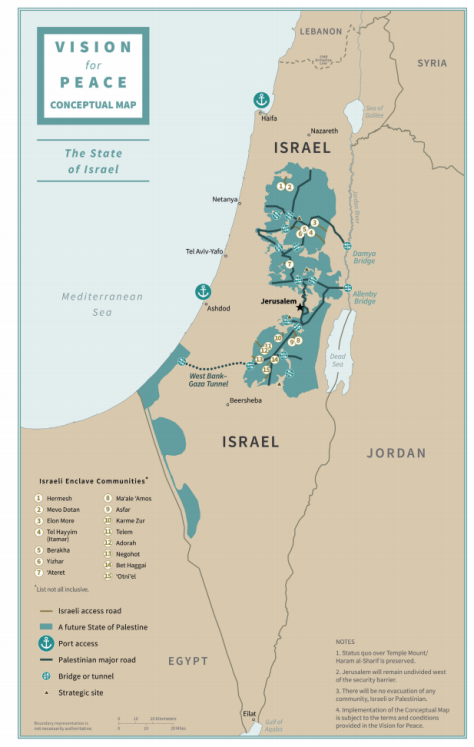 |
|
Source: White House, Peace to Prosperity: A Vision to Improve the Lives of the Palestinian and Israeli People, January 2020. |
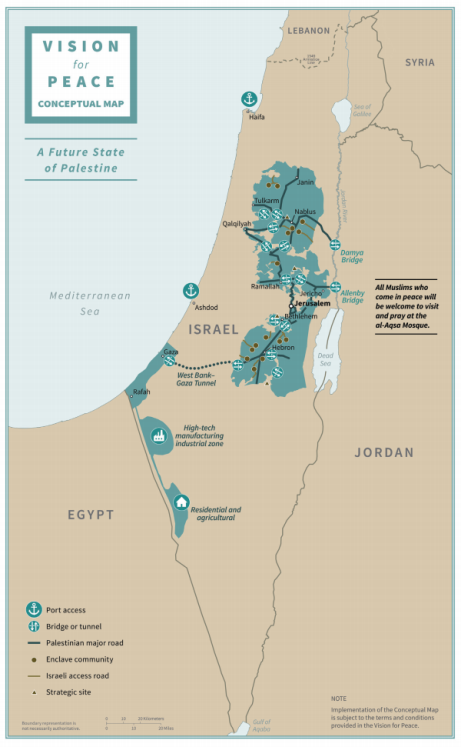 |
|
Source: White House, Peace to Prosperity: A Vision to Improve the Lives of the Palestinian and Israeli People, January 2020. |
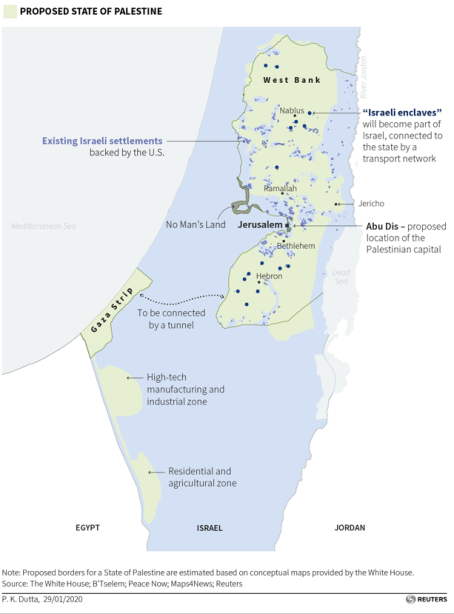 |
|
Notes: Green lines on map represent 1949-1967 Israel-Jordan armistice line (for West Bank) and 1950-1967 Israel-Egypt armistice line (for Gaza). All borders are approximate. |
